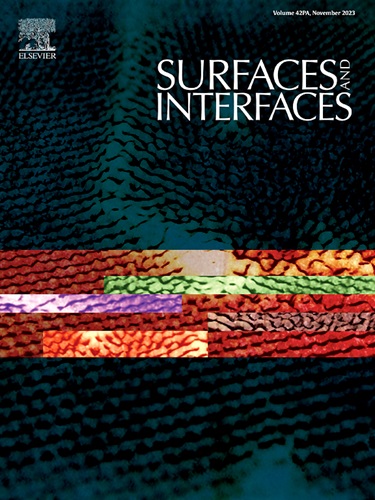低层二硫化钼缺陷态的深能级瞬态光谱及理论建模
IF 5.7
2区 材料科学
Q2 CHEMISTRY, PHYSICAL
引用次数: 0
摘要
原生缺陷可以从本质上影响半导体和基于它们的器件的性能。缺陷的影响对于从层状晶体中通过机械剥离获得的二维材料至关重要,因为大多数缺陷可能在剥离时引入。利用深能级瞬态光谱(DLTS)研究了SiO2/Si衬底上的MoS2薄片薄膜。在导带以下发现了一组能级分别为303、440和633 meV的电子陷阱。这些数值与密度泛函理论计算得到的结果进行了比较,这些计算结果是基于双层MoS2中最丰富的点缺陷,如Mo和S空位,Mo+S和S空位,或在表面S层中O取代S。计算结果表明,DLTS发现的三种状态分别为S空位(440 meV)和S空位(303和633 meV),是机械剥离法制备层状二维结构时最期望的。本文章由计算机程序翻译,如有差异,请以英文原文为准。
Deep level transient spectroscopy and theoretical modelling of defect states in few-layer MoS2
Native defects can essentially affect the properties of semiconductors and devices based on them. The defect influence is critical for 2D materials obtained by mechanical exfoliation from layered crystals, as most defects may be introduced when exfoliating. A film of few-layer MoS2 flakes on a SiO2/Si substrate was studied using deep-level transient spectroscopy (DLTS). A set of electron traps with energy levels at 303, 440, and 633 meV below the conduction band was found. The values are compared to those obtained by the density functional theory calculations of most abundant point defects in bilayer MoS2, such as Mo and S vacancies, Mo+S and S divacancies, or O substituting S in a surface S layer. Based on the calculation results, the three states found by DLTS were attributed to S vacancy (440 meV) and S divacancy (303 and 633 meV), being the most expected when preparing the layered 2D structures by mechanical exfoliation.
求助全文
通过发布文献求助,成功后即可免费获取论文全文。
去求助
来源期刊

Surfaces and Interfaces
Chemistry-General Chemistry
CiteScore
8.50
自引率
6.50%
发文量
753
审稿时长
35 days
期刊介绍:
The aim of the journal is to provide a respectful outlet for ''sound science'' papers in all research areas on surfaces and interfaces. We define sound science papers as papers that describe new and well-executed research, but that do not necessarily provide brand new insights or are merely a description of research results.
Surfaces and Interfaces publishes research papers in all fields of surface science which may not always find the right home on first submission to our Elsevier sister journals (Applied Surface, Surface and Coatings Technology, Thin Solid Films)
 求助内容:
求助内容: 应助结果提醒方式:
应助结果提醒方式:


